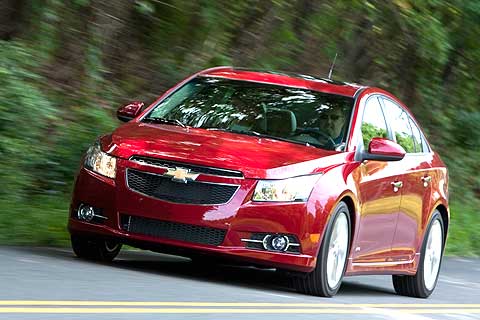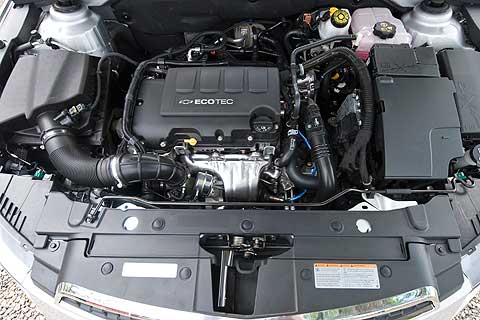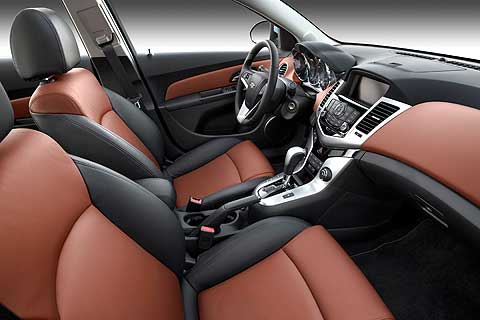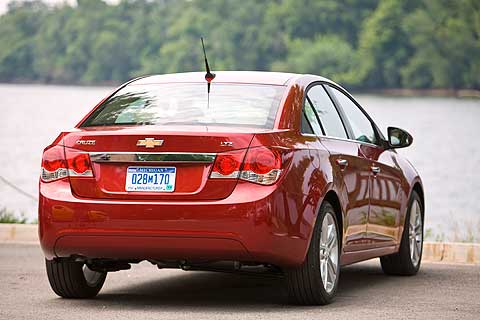General Motors has spent the past decade trying to build a compact car that seriously competes with Honda and Toyota, and it may finally have found the answer in the 2011 Chevy Cruze.

Chevrolet Cruze is designed to look and feel more expensive than it actually is. The body shows subtle European influence, most notably from Volkswagens and BMWs
2011 Chevrolet CruzeThe Cruze is a direct assault on the Honda Civic and Toyota Corolla, two vehicles that have topped the compact-car sales charts for years. Chevy has tried to beat them in the past by building a bad car, the Cavalier, and a decent car, the Cobalt, but the Cruze is the first one that actually comes close to whooping the Japanese giants at their own game. How close does it come? I took it on a test drive through rural Georgia to find out.
Styling
The first thing you notice about the Cruze is that it looks bigger than the "compact" class would suggest. The overall length is the same as the old Cobalt, but the wheels have been pushed to the corners to give it a more athletic, planted stance and to create more usable space in the cabin. It's two inches wider than the Cobalt, too, so it's not just an optical illusion.
The design draws inspiration from Europe, which is a great place to look if you like pretty cars. You can see a hint of Volkswagen Passat in the Cruze's roofline, along with some BMW in the shoulders and rear decklid. It's good inspiration indeed.
Inside, though, is where the Cruze really shines. It uses the same sweeping curves, soft-touch materials and subtle cabin lighting that make the latest Chevy Malibu look so classy. It's proof again that "new GM" knows how to build car interiors that have a premium feel without a premium price.
Driving Impressions

The Chevrolet Cruze base engine is a 1.8-liter four-cylinder, most buyers will want the 1.4-liter turbo
2011 Chevrolet Cruze EngineIf you think you know what it's like to drive a Chevy compact car, you'll be in for a very pleasant surprise with the Cruze. Chevy has built some truly awful cars through the years -- cars with engines that sound like a Weed Eater and tires that roar like a momma dinosaur -- but the Cruze does a great job of not feeling cheap. By using lots of sound-deadening tricks, such as acoustic laminated glass and special foam to keep the road noise out, it sounds more like you'd expect from a nice mid-size family car. The wind, engine and tires are all nicely muffled, even up to 80 mph.
That refined feeling is helped by a new engine that's smooth, quiet and efficient. The base engine is a hum-drum 1.8-liter four-cylinder, but most buyers will want the 1.4-liter turbo model. It's a smaller engine, but thanks to the turbocharger, it makes more power (138 hp) and gets better gas mileage.
For people who want to eke the most miles from a drop of gas, Chevy is making a special Eco version of the Cruze that is expected to get a hybrid-like 40 mpg on the highway. GM won't release any mileage numbers on other versions of the Cruze until EPA testing is complete, only saying the mileage will be "competitive" with the Civic and Corolla.
The new 1.4-liter turbocharged engine -- which will be built in Flint, Mich. -- feels buttery. It doesn't produce a huge wave of torque, but the power that comes is wonderfully smooth. It's an improvement over GM's older engine designs. The weak link in the Cruze, at least in the car I tested, is its transmission. It shifted abruptly under hard acceleration, changing gears with a "WHAM!" rather than a polite "excuse me" when I stomped the gas.
Comfort

The Chevrolet Cruze's interior is a smaller version of GM's resurgent masterpiece, the Malibu. It's proof yet again that Chevrolet can build interiors that feel luxurious without costing a fortune.
2011 Chevrolet Cruze InteriorThe Cruze makes good use of space, making it a small car that doesn't feel small.Thanks to the smart packaging, the front seat comes close to the level of comfort you'd expect in a mid-size car.
Some of the smartest use of space comes from a unique rear suspension design that leaves more room for the trunk. GM didn't choose an independent rear suspension, which is usually preferred because it offers a more precise driving feel and better handling, but instead invented something it calls the "Z-Link" suspension. Engineers say it can be tuned like an independent suspension, but doesn't come with the drawbacks of additional linkages that eat into the car's trunk space.
You can get some high-end options, including a navigation system and a high-powered Pioneer stereo system, but one of the most unique features -- and one that is sure to endear it to younger buyers -- is the ability to link the car to GM's iPhone app. With the app installed, you can start the car from your cell phone and see vehicle information such as the fuel level and tire pressure.
Safety
When it comes to the Cruze's safety features, there's just one number you need to know: 10. That's the number of airbags that safety engineers crammed into the cabin. Not only does it have the ordinary front, side and curtain airbags, but it also comes with air bags for your knees and for the sides of the rear passengers. It's like GM was trying to stuff airbags everywhere they would fit.
Other safety features include sensors to detect rollover accidents, electronic stability control, and more seatbelt pretensioners than most cars in this class.
Pricing

You can see a hint of Volkswagen Passat in the Chevrolet Cruze's roofline, along with some BMW in the shoulders and rear decklid
2011 Chevrolet Cruze RearThe base Cruze, called the LS, comes with air conditioning, power windows and locks, keyless entry, satellite radio and six months of free OnStar service and starts at $16,995. The LT model, which comes with the 1.4-liter engine and automatic transmission, is $18,895. The 2LT adds leather, power seats and other luxury features for $21,395, while the top-end LTZ is $22,695. The Eco model costs $18,895.
Overall
It's going to be hard for any car to knock Toyota and Honda off their perch, but this one comes remarkably close. It has a cabin that's better than anything else in this class -- by far -- along with the efficient Eco model that should get better gas mileage than the Civic and Corolla. When you combine it all together -- the efficiency, the comfort, the quality, the zillions of airbags -- it starts to make the Japanese competition look second-rate in some ways, which is a huge accomplishment for the once-humble Chevrolet.
Ratings
Style: 7
Performance: 6
Price: 9
Handling: 8
Ride: 7
Comfort: 9
Quality: 10
Overall: 7




